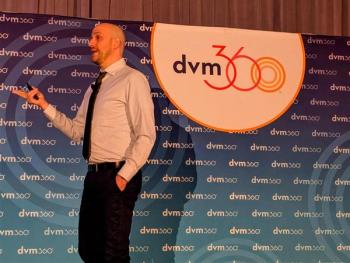
Upcoming trends in veterinary radiography: a biased radiologist's perspective (Proceedings)
Radiology is a technology driven and technology is rapidly changing. Knowing what is coming soon can alter the diagnostic options we offer clients but keeping up on all the technology can be a full time job. In veterinary radiology we are currently in a digital radiography hotbed.
Radiology is a technology driven and technology is rapidly changing. Knowing what is coming soon can alter the diagnostic options we offer clients but keeping up on all the technology can be a full time job. In veterinary radiology we are currently in a digital radiography hotbed.
Early adopters of CR, DR and CCD have had their systems for 5-7 years. Most early adopters are happy with their experience although there were some suboptimal systems . The next round of DR systems is now arriving with prices dropping and competition rising. Going hand and hand with digital radiography are viewing software and PACS. While PC viewing software or DICOM viewers remain the predominate player Osirix, a Mac based freeware, is gaining market share. The non-medical version of Osirix is an extremely robust and user friendly DICOM viewing software that can be downloaded from
Another upcoming trend in radiology is the remote rounds session. While podcasting has been around for a while the new online meeting software has allowed for remote rounds sessions with specialists. These rounds are unique in that each clinic is having their cases reviewed in real time while the doctors gather around a computer and discuss the cases with a specialist anywhere the internet can reach. This service leverages remote meeting and support programs to their full extent.
There has been a lot of talk about the Cloud PACS. What is it? Well the cloud PACS is your cases being stored off-site and accessed through the web rather than accessed locally. The plus to this is you don't have to worry about the IT of on-site PACS. The negative is that if your internet goes down or their system goes down you cannot access your images until service is restored. It is up to each clinic to decide what works best for them.
So what's next for the Cloud PACS? Well here is my personal bias and you will need to be present at the talk to hear it or be a client of
Ultrasound is another modality that is commonly used in both veterinary and human imaging. Ultrasound technology is changing due to improved computer processing. 3D imaging hit the market a few years ago and now with faster processors 4D, or real time 3D reconstruction imaging, is being used. The value of 3D and 4D remains to be proved and 3D imaging is mostly used for OBGYN imaging to give parents an early view of the child's face in utero.
Ultrasound contrast (non-targeted) seems to be showing some promise in abdominal imaging and treatment. For imaging ultrasound contrast for liver lesions seems to have a better predictive value than biopsies for differentiating benign from malignant liver lesions. Splenic lesions don't show as much promise. Contrast was originally used in cardiac imaging for myocardial infarcts and had some set-backs due to safety concerns. In the treatment arena ultrasound contrast offers the unique ability to use the contrast microbubble as a payload and the ultrasound wave as the selector for deploying that payload. Microbubbles allow for material to be packaged inside. These bubbles can be disrupted by the ultrasound wave allowing the internal material to be released where the ultrasound is being focused. This mechanism becomes even more promising with the use of targeted contrast. Targeted contrast refers to proteins on the bubble surface which allow the bubbles to stick to specific cell receptors. Targeted contrast could allow for early and specific tumor identification as well as focal treatment. Currently VICSD is involved in a study using targeted contrast for vascular endothelial growth factor (VEGF) and prostatic carcinoma detection.
Before we leave ultrasound let's discuss real time ultrasound. Real time ultrasound is a passion of mine and something I have been developing for the past few years. With improved computer and cellular technology it is now possible to stream ultrasound video from anywhere with adequate cellular coverage over the internet with a 3-5 second delay. At 20 frames per second and no reduction in resolution this allows a viewer anywhere the internet can reach to view a case being performed at that moment. On the human side, real time ultrasound also allows ultrasound video to be streamed from a moving ambulance or life flight directly to an awaiting ER clinician.
CT has been around for roughly 40 years. The first CT scans took hours. Current slip ring technology and multidetector systems allows for a thoracic scan to be performed in seconds. Multislice CTs in the human hospitals are obtaining 512 slices at one time. Veterinary medicine is now seeing 64 slice CTs being installed. The trade off is the amount of data is enormous and review of all the images can be an exhaustive process.
MRI technology is improving with higher field strength and improved coil design. Higher field strength allows for shorter scans with the same resolution or improved resolution if scan time is longer (similar scan times to lower field magnets). Coil design has increased channel number to improve image resolution. Also high temperature coils are an unproved technology but one that promises to increase signal to noise by 100-500%. If functional this could make low field images equivalent to 1-1.5T images.
Interventional radiology is making its presence in veterinary medicine. IR is primarily being used for coil placement in intrahepatic portosystemic shunts, tumor embolization and congenital cardiac defects such as PDA or VSDs.
PET CT is being used at a few universities. PET or Positron Emission Tomography and CT are fused to create functional and anatomic images. The PET portion identified glucose uptake. Tumors, infection, brain and kidneys/ bladder are the primary places for glucose uptake. PET CT is used extensively in human radiology for tumor staging and fever or unknown origin.
Finally, radiology may be mimicking Hollywood. For those who remember Tom Cruise at the review board in Minority Report you will recognize the similarities to a new project from Switzerland which uses Microsoft's connect and Osirix. Using connect the user is able to interface with the Osirix commands via voice and hand movements rather than through a mouse and keyboard.
Remember this is a partial list of developing radiology technology which in itself is a moving target. Great things are in store for tomorrow's imaging options.
Disclaimer: Seth Wallack DVM, DACVR has a financial interest in Vetology and Real Time ultrasound.
Newsletter
From exam room tips to practice management insights, get trusted veterinary news delivered straight to your inbox—subscribe to dvm360.






